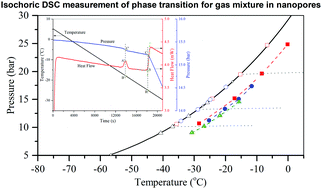Simple and accurate isochoric differential scanning calorimetry measurements: phase transitions for pure fluids and mixtures in nanopores
Abstract
Various types of nanopores are encountered in many different engineering and science applications. Due to incomplete understanding of the phase behavior of fluids in nanosize confined space, the improvement of such applications has been largely based on experience and empirical approaches. Therefore, experimental studies on the phase behavior of confined fluids that are simple but accurate are still urgently needed. We recently developed a new isochoric procedure using a Differential Scanning Calorimeter (DSC) to measure the onset of vapor–liquid phase transitions, which has been successfully used in experiments measuring the vapor pressures of pure substances and the dew points of a bulk mixture in the absence of nanopores [Qiu et al., Phys. Chem. Chem. Phys., 2018, 20, 26241–26248]. It is the purpose of this work to extend the new method to confined fluids. To demonstrate the superior ability of the new method, we measure the capillary condensation of CO2 and the dew points of a binary methane/ethane gas mixture confined in SBA-15 with different pore diameters.



 Please wait while we load your content...
Please wait while we load your content...